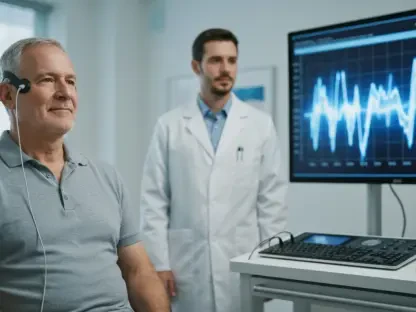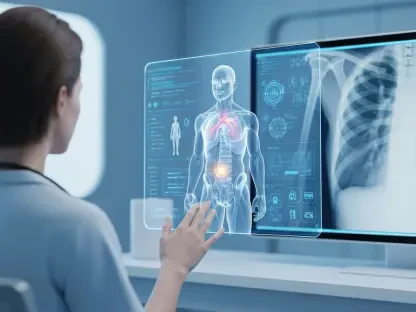The convergence of artificial intelligence and robotics promises significant advances in modern medicine, a topic recently underscored by the successful patient enrollment in the CANSCAN clinical trial. Spearheaded by Vexev, a prominent Australian medical device company, and U.S. Renal Care, this trial seeks to explore the potential of the VxWave™ Ultrasound Imaging System. The technology, considered semi-autonomous, aims to facilitate arteriovenous fistula mapping within dialysis clinics using sophisticated robotic systems and AI-driven processes. Dialysis clinics may soon witness a shift in practice where the necessity for traditional imaging appointments outside the facility is drastically reduced, enhancing patient comfort and clinical outcomes.
A New Era in Vascular Imaging
VxWave™ Ultrasound Imaging System Innovations
The VxWave™ Ultrasound Imaging System utilizes a combination of cutting-edge technology, integrating robotics, machine learning, and advanced ultrasound signal processing. Designed specifically for upper limb vascular imaging, it creates 3D vascular models and comprehensive reports. These innovations have the potential to transform the approach to vascular access in dialysis, allowing for thorough imaging directly at the point of care. The development of vascular images and models through the VxWave system could streamline patient processes, eliminating the need for complicated scheduling and travel while ensuring prompt medical assessments. This could open avenues for more rapid and effective intervention, addressing the needs of patients suffering from end-stage kidney disease who require regular and reliable dialysis treatment.
Overcoming Traditional Barriers
The integration of the VxWave technology in healthcare facilities marks a significant stride in overcoming traditional barriers in medical imaging. By enabling patients to receive essential imaging within their dialysis center, the system reduces logistical challenges and delays often associated with external imaging services. Dr. Varshi Broumand, the principal investigator for the CANSCAN study, points out the convenience this technology offers, providing dialysis patients with immediate access to their necessary images and reports. This technological evolution is set to enhance the standard of care, aligning with the broader trend of employing intelligent robotics in healthcare to bolster operational efficiencies without direct human involvement. By facilitating instant imaging access, the system not only optimizes the workflow of healthcare providers but also promises improved patient experiences and outcomes.
Intelligent Robotics in Medical Imaging
Advancements in Precision Imaging
A notable advance in the field of precision medical imaging comes through the integration of intelligent robotics, as showcased in the CANSCAN clinical trial. The semi-autonomous nature of the VxWave system ensures high accuracy in vascular mapping without the need for continual human operation, a shift supported by Vexev’s Chief Medical Officer, Shannon Thomas, MD. This development hints at a future where complex medical imaging tasks are conducted by machines with unparalleled precision. Such progress may redefine clinical practices, improving procedural accuracy, reducing human error, and allowing healthcare professionals to redirect their focus toward more critical tasks requiring human insight and decision-making.
Transforming Patient Care and Outcomes
The ability to conduct complex imaging tasks effectively and autonomously presents a transformative change for patient care. Intelligent robotic systems present the opportunity to enhance the quality and reliability of medical imaging, a crucial factor in managing chronic conditions like end-stage kidney disease. The CANSCAN trial is expected to demonstrate the clinical benefits of these technologies, showcasing how they can support timely and informed medical decisions. The comprehensive data and rapid imaging provided by the VxWave system are set to offer healthcare professionals intricate insights, allowing for improved monitoring and treatment planning. Longer term, this robotic-assisted approach may evolve into a standard practice within medical facilities, shedding light on the future capabilities of AI in clinical settings.
Rethinking the Future of Medical Imaging
Pioneering Clinical Innovations
The integration of robotic systems and AI in healthcare opens the door to clinical innovations previously deemed theoretical. The CANSCAN trial stands as a testament to how technology can translate abstract advances into practical applications that enhance patient care. With a focus on validation, the trial promises to highlight the effectiveness and feasibility of robotic-assisted imaging, stressing its significance in routine medical processes. If successful, the insights gained from the trial may encourage broader adoption of intelligent systems, inspiring healthcare practices globally to re-evaluate their imaging protocols and embrace novel solutions aimed at refining clinical accuracy.
Engaging with AI’s Clinical Potential
The convergence of artificial intelligence and robotics in modern medicine heralds substantial advancements, as demonstrated by the CANSCAN clinical trial’s successful patient enrollment. Led by Vexev, an esteemed Australian medical device company, in collaboration with U.S. Renal Care, this trial investigates the capabilities of the innovative VxWave™ Ultrasound Imaging System. This semi-autonomous technology focuses on mapping arteriovenous fistulas within dialysis clinics, utilizing cutting-edge robotic systems enhanced by AI processes. The objective is to revolutionize dialysis clinic practices by minimizing the need for conventional imaging appointments outside the facility, thereby improving patient convenience and clinical results. By integrating these advanced technologies into daily operations, dialysis clinics may see increased efficiency, allowing healthcare providers to focus more on patient care rather than logistical challenges, thus fostering a more patient-centered approach in medical treatment.









